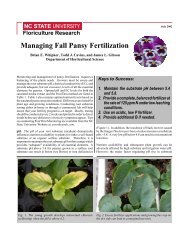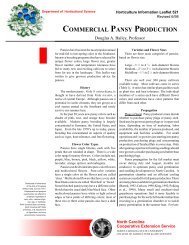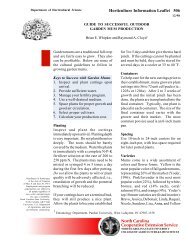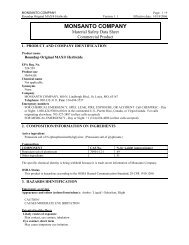For Safety's Sake… Making Pickles in North Carolina
For Safety's Sake… Making Pickles in North Carolina
For Safety's Sake… Making Pickles in North Carolina
You also want an ePaper? Increase the reach of your titles
YUMPU automatically turns print PDFs into web optimized ePapers that Google loves.
<strong>For</strong> Safety’s Sake . . .<br />
<strong>Mak<strong>in</strong>g</strong> <strong>Pickles</strong> <strong>in</strong><br />
<strong>North</strong> Carol<strong>in</strong>a<br />
Pickl<strong>in</strong>g is a way to preserve food by us<strong>in</strong>g salt, v<strong>in</strong>egar, and/or sugar. There are many<br />
types of pickles. Each calls for a different comb<strong>in</strong>ation of <strong>in</strong>gredients and preparation<br />
methods.<br />
No matter which type you make, you must ma<strong>in</strong>ta<strong>in</strong> the acidity of the pickl<strong>in</strong>g br<strong>in</strong>e below<br />
4.6 if you use water bath cann<strong>in</strong>g. You can do this only by us<strong>in</strong>g v<strong>in</strong>egar that is at least 5<br />
percent acetic (or 50 gra<strong>in</strong>s).<br />
TYPES OF PICKLES<br />
Fermented pickles are vegetables soaked <strong>in</strong> a br<strong>in</strong>e solution for 4 to 6 weeks. Dur<strong>in</strong>g<br />
this time, lactic acid bacteria, naturally present on the surface of vegetables,<br />
grows. Other microbes are <strong>in</strong>hibited by salt. The color of the<br />
vegetables changes from bright green to olive/yellow-green, and the white<br />
<strong>in</strong>terior becomes translucent. Examples <strong>in</strong>clude dill pickles and sauerkraut.<br />
Refrigerated dills are cucumbers fermented for 1 week <strong>in</strong> a salt br<strong>in</strong>e and then<br />
stored <strong>in</strong> the refrigerator for up to 2 months.<br />
Fresh-pack (or quick process) pickles are cured for several hours <strong>in</strong> a v<strong>in</strong>egar solution<br />
or are immediately comb<strong>in</strong>ed with hot v<strong>in</strong>egar, spices, and season<strong>in</strong>gs.<br />
Examples <strong>in</strong>clude bread-and-butter pickles and pickled beets.<br />
Fruit pickles are whole or sliced fruit simmered <strong>in</strong> a spicy, sweet-sour syrup.<br />
Examples <strong>in</strong>clude spiced peaches and crabapples.<br />
Relishes are made from chopped fruits or vegetables that are cooked to a desired<br />
consistency <strong>in</strong> a spicy v<strong>in</strong>egar solution. Examples <strong>in</strong>clude corn relish and<br />
horseradish.<br />
INGREDIENTS<br />
Distributed <strong>in</strong> furtherance<br />
of the Acts of Congress<br />
of May 8 and June 30, 1914.<br />
Employment and program<br />
opportunities are offered to<br />
all people regardless of<br />
race, color, national orig<strong>in</strong>,<br />
sex, age, or disability.<br />
<strong>North</strong> Carol<strong>in</strong>a State University,<br />
<strong>North</strong> Carol<strong>in</strong>a A&T State<br />
University, U.S. Department<br />
of Agriculture, and local<br />
governments cooperat<strong>in</strong>g.<br />
Vegetables or fruits for pickl<strong>in</strong>g<br />
• Choose fruits and vegetables that are firm but ripe and <strong>in</strong> good condition with no<br />
evidence of disease or <strong>in</strong>sect damage.<br />
• Remove the blossom end of the cucumbers. The blossom conta<strong>in</strong>s enzymes that<br />
cause soften<strong>in</strong>g of the f<strong>in</strong>al pickle product.<br />
• Use unwaxed cucumbers for pickl<strong>in</strong>g so br<strong>in</strong>e will penetrate.<br />
• Discard any cucumbers that “float.” Gas is produced <strong>in</strong>side these cucumbers,<br />
mak<strong>in</strong>g them hollow. These cucumbers can be used for relish.<br />
• Prepare fruits and vegetables for pickl<strong>in</strong>g with<strong>in</strong> 24 hours of harvest.
• Pickle yields:<br />
• Use 14 pounds of cucumbers for a 7-quart<br />
canner load.<br />
• Use 9 pounds of cucumbers for a 9-p<strong>in</strong>t<br />
canner load.<br />
• One bushel weighs 48 pounds and yields 16 to<br />
24 quarts (2 pounds per quart).<br />
• Use cucumbers that are 1 1/2 <strong>in</strong>ches long to<br />
make gherk<strong>in</strong>s and 4 <strong>in</strong>ches long to make dills.<br />
V<strong>in</strong>egar<br />
V<strong>in</strong>egar must be at least 5 percent acetic so that lowacid<br />
vegetables such as cucumbers are properly acidified.<br />
Never dilute the amount of v<strong>in</strong>egar stated <strong>in</strong> a<br />
recipe. <strong>For</strong> every cup of water, add 1 cup of v<strong>in</strong>egar.<br />
The acid must be uniform throughout the vegetable to<br />
prevent the growth of botul<strong>in</strong>um bacteria.<br />
Use white v<strong>in</strong>egar to pickle light-colored fruits and<br />
vegetables. Never use homemade v<strong>in</strong>egar—there is no<br />
way to know its true acidity.<br />
Salt<br />
Use cann<strong>in</strong>g or pickl<strong>in</strong>g salt because they conta<strong>in</strong> no<br />
iod<strong>in</strong>e. Iod<strong>in</strong>e can cause darken<strong>in</strong>g of the pickles<br />
because it conta<strong>in</strong>s anti-cak<strong>in</strong>g <strong>in</strong>gredients such as<br />
sodium silicate or tricalcium phosphate, (which also<br />
causes cloudy br<strong>in</strong>e).<br />
In fermented pickles, salt <strong>in</strong>hibits the growth of<br />
undesirable microorganisms. Salt also draws water out<br />
of the vegetable, mak<strong>in</strong>g the pickle more firm. Too<br />
much salt causes shrivel<strong>in</strong>g. Never reduce the amount<br />
of salt <strong>in</strong> a fermented pickle recipe.<br />
Never use “sour salt.” Sour salt is citric acid and<br />
does not <strong>in</strong>hibit the growth of microorganisms that<br />
cause fermented pickles to spoil.<br />
If you use reduced-sodium salt, use it only for freshpack<br />
pickles—never for fermented pickles. Fresh-pack<br />
pickles are acidified with v<strong>in</strong>egar, so they can be<br />
prepared with less or no salt. However, their flavor<br />
and texture might be affected.<br />
Sugar<br />
Use either white or brown granulated sugar. Brown<br />
sugar turns light-colored vegetables dark. Make your<br />
choice based on your color or flavor preference.<br />
Spices<br />
Use fresh, whole spices packed <strong>in</strong> a cheesecloth bag.<br />
Powdered spices cause darken<strong>in</strong>g and cloudy br<strong>in</strong>e.<br />
Water<br />
Hard water often <strong>in</strong>terferes with acid formation <strong>in</strong><br />
fermented pickles. Also, hard water with a pH of 8.0<br />
or higher can affect the acidity of the cur<strong>in</strong>g br<strong>in</strong>e.<br />
To soften hard water, boil it for 15 m<strong>in</strong>utes, then let<br />
it stand for 24 hours. Skim off any scum that appears.<br />
Pour the water out of the conta<strong>in</strong>er so sediment is not<br />
disturbed.<br />
Firm<strong>in</strong>g Agents<br />
Alum can be safely used to firm fermented pickles,<br />
but it is not necessary. Alum does not improve the<br />
firmness of fresh-pack pickles—the calcium <strong>in</strong> the lime<br />
does that. To improve the crispness, soak cucumbers<br />
<strong>in</strong> a solution of 1 tablespoon lime per quart of water<br />
for 12 to 24 hours before fermentation. Excess lime<br />
absorbed by the cucumbers must be removed to make<br />
safe pickles. To remove excess lime, dra<strong>in</strong> the limewater<br />
solution, r<strong>in</strong>se the cucumbers, and then resoak<br />
them <strong>in</strong> fresh water for 1 hour. Repeat the r<strong>in</strong>s<strong>in</strong>g and<br />
soak<strong>in</strong>g steps two more times.<br />
PREVENTING SPOILAGE<br />
Pickle products are subject to spoilage from yeasts<br />
and molds and from enzymes that might affect flavor,<br />
color, and texture. Process<strong>in</strong>g pickles <strong>in</strong> a water bath<br />
canner will prevent this. Always use standard cann<strong>in</strong>g<br />
jars; two-piece cann<strong>in</strong>g lids are recommended. Process<strong>in</strong>g<br />
times and procedures vary depend<strong>in</strong>g on the<br />
food be<strong>in</strong>g pickled.<br />
EQUIPMENT FOR SUCCESSFUL<br />
PICKLING<br />
Us<strong>in</strong>g the right type of equipment saves time and<br />
energy. Read the entire recipe before beg<strong>in</strong>n<strong>in</strong>g to<br />
prepare pickles. Have all the utensils and tools you<br />
need ready to use.<br />
Utensils<br />
Heat pickl<strong>in</strong>g solutions <strong>in</strong> conta<strong>in</strong>ers of unchipped<br />
enamelware, sta<strong>in</strong>less steel, alum<strong>in</strong>um, or glass. Never<br />
use copper, brass, galvanized, or iron utensils; the<br />
metals might react with acids or salts and cause undesirable<br />
color changes <strong>in</strong> the pickles or form undesirable<br />
compounds.<br />
When mak<strong>in</strong>g fermented pickles, use an unglazed<br />
crock or stone jar, an unchipped enamel-l<strong>in</strong>ed pan, or<br />
a large glass jar, bowl, or casserole. Use a heavy plate<br />
or large glass lid that fits <strong>in</strong>side the conta<strong>in</strong>er to cover<br />
vegetables <strong>in</strong> the br<strong>in</strong>e. Use a weight to hold the cover<br />
down and keep vegetables below the surface of the<br />
br<strong>in</strong>e. A glass jar filled with br<strong>in</strong>e makes a good<br />
weight. A food-grade, heavyweight plastic bag filled<br />
with br<strong>in</strong>e is another effective weight. Fill the bag with<br />
enough br<strong>in</strong>e to form a tight-fitt<strong>in</strong>g cover over the<br />
vegetables. Tie it tightly so the br<strong>in</strong>e will not leak out.<br />
2
<strong>For</strong> added protection, put the br<strong>in</strong>e-filled bag <strong>in</strong>side<br />
another heavyweight plastic bag <strong>in</strong>tended for food use.<br />
Check the bags daily for leaks. If a small amount of the<br />
br<strong>in</strong>e leaks out, it will not hurt the ferment<strong>in</strong>g vegetables.<br />
But still replace the bag because there is a<br />
greater chance of leak<strong>in</strong>g the longer the solution stays<br />
<strong>in</strong> the bag.<br />
Do not cover ferment<strong>in</strong>g cucumbers with a plastic<br />
bag. Cucumbers sometimes become hollow dur<strong>in</strong>g<br />
fermentation due to a buildup of carbon dioxide <strong>in</strong>side<br />
the cucumber. The br<strong>in</strong>e surface should not be tightly<br />
sealed so the carbon dioxide can escape.<br />
Small utensils that make preparation easier <strong>in</strong>clude:<br />
measur<strong>in</strong>g spoons<br />
sharp knives<br />
large trays<br />
tongs<br />
vegetable peelers<br />
food chopper/gr<strong>in</strong>der<br />
ladle with lip<br />
slotted spoon<br />
footed colander<br />
wire basket<br />
funnel<br />
cutt<strong>in</strong>g board<br />
Scales<br />
The use of scales to weigh <strong>in</strong>gredients, especially<br />
when ferment<strong>in</strong>g, is important. They are essential <strong>in</strong><br />
mak<strong>in</strong>g sure the proportions of vegetables by weight<br />
to salt is accurate for successful fermentation. Good<br />
household scales are readily available and not expensive.<br />
Water bath canner<br />
Inexpensive water bath canners are available at many<br />
hardware and variety stores. However, any large metal<br />
conta<strong>in</strong>er can be used if it:<br />
• Is deep enough to allow for 1 to 2 <strong>in</strong>ches of water<br />
above the tops of the jars, plus a little extra space<br />
for boil<strong>in</strong>g.<br />
• Has a close-fitt<strong>in</strong>g cover.<br />
• Has a rack with partitions to keep jars from<br />
touch<strong>in</strong>g each other and hitt<strong>in</strong>g the sides of the<br />
canner.<br />
• A steam-pressure canner can serve as a water bath.<br />
To use it for this purpose, set the cover <strong>in</strong> place<br />
without fasten<strong>in</strong>g it. Be sure the petcock is wide<br />
open so that steam escapes and pressure does not<br />
build up.<br />
Glass jars and lids<br />
Use jars designed for home cann<strong>in</strong>g. Other jars<br />
break more easily or do not seal properly.<br />
Use jars that are free of cracks, chips, or any other<br />
defect. Run your f<strong>in</strong>ger carefully along the rims of the<br />
jars to check for these defects. Lids must be free of<br />
rust and dents. Always use new flat, rubber-l<strong>in</strong>ed metal<br />
lids. Faulty jars and lids result <strong>in</strong> faulty seals, which<br />
might allow the product to spoil faster or become<br />
unsafe.<br />
Before pack<strong>in</strong>g products <strong>in</strong>to jars, wash jars <strong>in</strong><br />
hot, soapy water or <strong>in</strong> your dishwasher.<br />
PROCEDURES FOR PICKLING<br />
To ensure acceptable quality and safety of the<br />
pickle product, follow these procedures:<br />
Pack<strong>in</strong>g jars<br />
Uniformly pack pickle products <strong>in</strong>to jars before<br />
process<strong>in</strong>g. Do not pack tightly. Leave enough<br />
room for the br<strong>in</strong>e or syrup to surround the product.<br />
Leave 1/2-<strong>in</strong>ch headspace (headspace is the<br />
space between the top of the product <strong>in</strong>side the jar<br />
and the bottom of the lid).<br />
Wipe the rim and threads of the jar with a clean<br />
cloth. Small food particles on the rim could result<br />
<strong>in</strong> a faulty seal.<br />
Clos<strong>in</strong>g jars<br />
Use the two-piece cann<strong>in</strong>g lid (flat metal lid and<br />
screw band) to seal the jar. Put the lids <strong>in</strong> boil<strong>in</strong>g<br />
water for a few seconds before use. Put the lid on<br />
the jar with the seal<strong>in</strong>g compound (the rubber-like<br />
substance on the lid that secures the seal) next to<br />
the glass. Screw on the metal band. When the band<br />
is screwed hand tight, the lid has enough “give” to<br />
let air escape dur<strong>in</strong>g process<strong>in</strong>g. Do not tighten the<br />
screw band further after process<strong>in</strong>g.<br />
If liquid has boiled out of a jar dur<strong>in</strong>g process<strong>in</strong>g,<br />
do not open it to add more liquid because spoilage<br />
organisms might contam<strong>in</strong>ate the product. Loss of<br />
liquid does not cause food to spoil; however, the<br />
vegetables at the top of the jar might darken or dry<br />
out.<br />
Heat treatment<br />
Pickle products must undergo heat treatment to<br />
destroy spoilage organisms and to <strong>in</strong>activate enzymes<br />
that affect flavor, color, and texture of the<br />
product dur<strong>in</strong>g storage. Process <strong>in</strong> a water bath<br />
canner for the time outl<strong>in</strong>ed <strong>in</strong> timetable. Openkettle<br />
cann<strong>in</strong>g is not recommended.<br />
Immerse the jars <strong>in</strong> actively boil<strong>in</strong>g water <strong>in</strong> a<br />
canner. Water must cover the jars at least 1 to 2<br />
<strong>in</strong>ches. Return the water to boil<strong>in</strong>g as quickly as<br />
possible. Beg<strong>in</strong> count<strong>in</strong>g process<strong>in</strong>g time when the<br />
water returns to a boil, and cont<strong>in</strong>ue to boil gently<br />
for the time recommended.<br />
Process<strong>in</strong>g procedures for fermented cucumbers<br />
and fresh-pack pickles are slightly different from<br />
3
normal water bath procedures. <strong>For</strong> these products,<br />
start to count the process<strong>in</strong>g time as soon as the filled<br />
jars are placed <strong>in</strong> the actively boil<strong>in</strong>g water. This<br />
prevents development of a cooked flavor and loss of<br />
crispness.<br />
Process<strong>in</strong>g times given <strong>in</strong> the recipes that follow are<br />
for altitudes less than 1,000 feet above sea level. At<br />
altitudes of 1,000 feet or above, <strong>in</strong>crease process<strong>in</strong>g<br />
times by 1 m<strong>in</strong>ute for each 1,000 feet above sea level.<br />
Cool<strong>in</strong>g the canned pickles<br />
To cool the jars, put them upright on a wire rack or<br />
folded towel, leav<strong>in</strong>g several <strong>in</strong>ches between jars to<br />
allow free circulation of air. Keep the jars out of drafts.<br />
Do not cover them.<br />
Cool for 12 to 24 hours. Remove metal screw bands<br />
and check jars for a seal. If the center of the lid has a<br />
slight dip or stays down after process<strong>in</strong>g, the jar is<br />
sealed. Refrigerate jars that did not seal, or reprocess<br />
them. Reprocess<strong>in</strong>g results <strong>in</strong> a soft product.<br />
Stor<strong>in</strong>g the canned pickles<br />
Remove the metal screw bands from the two-piece<br />
lids so they will not rust. You can loosen stick<strong>in</strong>g<br />
bands by cover<strong>in</strong>g them with a hot, damp cloth for a<br />
short time. Wash the bands and dry them thoroughly<br />
for reuse. Wipe jars with a clean, damp cloth and label<br />
them with the name of the product and date. Store <strong>in</strong> a<br />
dark, dry, cool place where there is no danger of<br />
freez<strong>in</strong>g.<br />
Before open<strong>in</strong>g a jar, exam<strong>in</strong>e it carefully. A bulg<strong>in</strong>g<br />
lid or leakage means the contents are spoiled. When a<br />
jar is opened, look for signs of spoilage, such as:<br />
•Spurt<strong>in</strong>g liquid<br />
•Mold<br />
•Disagreeable odor<br />
•Change <strong>in</strong> color, or<br />
•An unusual softness, mush<strong>in</strong>ess,<br />
or slipper<strong>in</strong>ess of the pickle product.<br />
If there is even the slightest <strong>in</strong>dication of spoilage,<br />
do not eat—or even taste—the product. Dispose of the<br />
contents so they cannot be eaten by people or animals.<br />
4
Pickle Recipes<br />
Quick Fresh-Pack Dill <strong>Pickles</strong><br />
8 lb of 3- to 5-<strong>in</strong>ch pickl<strong>in</strong>g cucumbers<br />
2 gallons water<br />
l l/4 to l l/2 cups cann<strong>in</strong>g or pickl<strong>in</strong>g salt<br />
l l/2 qt v<strong>in</strong>egar (5 percent acidity)<br />
l/4 cup sugar<br />
2 to 2 l/4 qt water<br />
2 Tbsp whole mixed pickl<strong>in</strong>g spice<br />
3 to 5 Tbsp whole mustard seed<br />
(1 to 2 tsp per p<strong>in</strong>t jar)<br />
About 14 to 2l heads of fresh dill<br />
(l l/2 to 3 heads per p<strong>in</strong>t jar)<br />
or<br />
4 l/2 to 7 Tbsp dill seed (l l/2 tsp to<br />
l Tbsp per p<strong>in</strong>t jar)<br />
Yield: 7 to 9 p<strong>in</strong>ts<br />
Procedure: Wash cucumbers. Cut l/l6-<strong>in</strong>ch slice off<br />
blossom end and discard, but leave l/4-<strong>in</strong>ch of stem<br />
attached. Dissolve 3/4 cup salt <strong>in</strong> 2 gallons water.<br />
Pour over cucumbers and let stand l2 hours. Dra<strong>in</strong>.<br />
Comb<strong>in</strong>e v<strong>in</strong>egar, l/2 cup salt, sugar, and 2 quarts<br />
water. Add mixed pickl<strong>in</strong>g spices tied <strong>in</strong> a clean white<br />
cloth. Heat to boil<strong>in</strong>g. Fill jars with cucumbers. Add l<br />
tsp mustard seed and l l/2 heads fresh dill per p<strong>in</strong>t.<br />
Cover with boil<strong>in</strong>g pickl<strong>in</strong>g solution, leav<strong>in</strong>g l/2-<strong>in</strong>ch<br />
headspace. Adjust lids. Process p<strong>in</strong>ts for 10 m<strong>in</strong>utes<br />
and quarts for 15 m<strong>in</strong>utes <strong>in</strong> a boil<strong>in</strong>g water canner.<br />
Bread-and-Butter <strong>Pickles</strong><br />
6 lb of 4- to 5-<strong>in</strong>ch pickl<strong>in</strong>g cucumbers<br />
8 cups th<strong>in</strong>ly sliced onions (about 3 pounds)<br />
l/2 cup cann<strong>in</strong>g or pickl<strong>in</strong>g salt<br />
4 cups v<strong>in</strong>egar (5 percent acidity)<br />
4 l/2 cups sugar<br />
2 Tbsp mustard seed<br />
l l/2 Tbsp celery seed<br />
l Tbsp ground tumeric<br />
Yield: About 8 p<strong>in</strong>ts<br />
Procedure: Wash cucumbers. Cut l/l6-<strong>in</strong>ch off<br />
blossom end and discard. Cut <strong>in</strong>to 3/l6-<strong>in</strong>ch slices.<br />
Comb<strong>in</strong>e cucumbers and onions <strong>in</strong> a large bowl. Add<br />
salt. Cover with 2 <strong>in</strong>ches crushed or cubed ice. Refrigerate<br />
3 to 4 hours, add<strong>in</strong>g more ice as needed.<br />
Comb<strong>in</strong>e rema<strong>in</strong><strong>in</strong>g <strong>in</strong>gredients <strong>in</strong> a large pot. Boil<br />
l0 m<strong>in</strong>utes. Dra<strong>in</strong> and add cucumbers and onions,<br />
slowly reheat<strong>in</strong>g to boil<strong>in</strong>g. Fill jars with slices and<br />
cook<strong>in</strong>g syrup, leav<strong>in</strong>g l/2-<strong>in</strong>ch headspace. Adjust lids.<br />
Process p<strong>in</strong>ts or quarts for l0 m<strong>in</strong>utes <strong>in</strong> a boil<strong>in</strong>g<br />
water canner.<br />
Storage: After process<strong>in</strong>g and cool<strong>in</strong>g jars, store<br />
them 4 to 5 weeks to develop ideal flavor.<br />
Variation: Squash bread-and-butter pickles. Substitute<br />
slender (l to l l/2 <strong>in</strong>ches <strong>in</strong> diameter) zucch<strong>in</strong>i or<br />
yellow summer squash for cucumbers.<br />
Quick Sweet <strong>Pickles</strong><br />
8 lb of 3- to 4-<strong>in</strong>ch pickl<strong>in</strong>g cucumbers<br />
(may be canned as strips or slices)<br />
l/3 cup cann<strong>in</strong>g or pickl<strong>in</strong>g salt<br />
4 l/2 cups sugar<br />
3 l/2 cups v<strong>in</strong>egar (5 percent)<br />
2 tsp celery seed<br />
l Tbsp whole allspice<br />
2 Tbsp mustard seed<br />
Yield: About 7 to 9 p<strong>in</strong>ts<br />
Procedure: Wash cucumbers. Cut l/l6-<strong>in</strong>ch off<br />
blossom end and discard, but leave l/4 <strong>in</strong>ch of stem<br />
attached. Slice or cut <strong>in</strong>to strips if desired. Place <strong>in</strong><br />
bowl and spr<strong>in</strong>kle with l/3 cup salt. Cover with 2<br />
<strong>in</strong>ches of crushed or cubed ice. Refrigerate 3 to 4<br />
hours. Add more ice as needed. Dra<strong>in</strong> well.<br />
Comb<strong>in</strong>e sugar, v<strong>in</strong>egar, celery seed, allspice, and<br />
mustard seed <strong>in</strong> a 6-quart kettle. Heat to boil<strong>in</strong>g.<br />
Hot Pack—Add cucumbers to v<strong>in</strong>egar solution and<br />
heat slowly until it returns to boil. Stir occasionally to<br />
make sure mixture heats evenly. Fill sterile jars,<br />
leav<strong>in</strong>g l/2-<strong>in</strong>ch headspace. Adjust lids. Process for 5<br />
m<strong>in</strong>utes <strong>in</strong> a boil<strong>in</strong>g water canner.<br />
Raw Pack—Fill jars, leav<strong>in</strong>g l/2-<strong>in</strong>ch headspace.<br />
Add hot pickl<strong>in</strong>g syrup, leav<strong>in</strong>g l/2-<strong>in</strong>ch headspace.<br />
Adjust lids. Process p<strong>in</strong>ts for l0 m<strong>in</strong>utes and quarts for<br />
l5 m<strong>in</strong>utes <strong>in</strong> a boil<strong>in</strong>g water canner.<br />
Storage: After process<strong>in</strong>g and cool<strong>in</strong>g jars, store<br />
them 4 to 5 weeks to develop ideal flavor.<br />
Variation: Add 2 slices of raw onion to each jar<br />
before fill<strong>in</strong>g with cucumbers.<br />
Sauerkraut<br />
25 lb of cabbage<br />
3/4 cup cann<strong>in</strong>g or pickl<strong>in</strong>g salt<br />
Quality: <strong>For</strong> the best sauerkraut, use firm heads of<br />
fresh cabbage. Shred cabbage and start kraut between<br />
24 and 48 hours after harvest.<br />
Yield: About 9 quarts<br />
Procedure: Work with about 5 pounds of cabbage at<br />
a time. Discard outer leaves. R<strong>in</strong>se heads under cold<br />
runn<strong>in</strong>g water and dra<strong>in</strong>. Cut heads <strong>in</strong>to quarters and<br />
5
emove cores. Shred or slice to the thickness of 1/4<br />
or 1/8 <strong>in</strong>ch. Put cabbage <strong>in</strong> a suitable fermentation<br />
conta<strong>in</strong>er, and add 3 tablespoons of salt. Mix thoroughly,<br />
us<strong>in</strong>g clean hands. Pack firmly until salt draws<br />
juices from cabbage. Repeat shredd<strong>in</strong>g, salt<strong>in</strong>g, and<br />
pack<strong>in</strong>g until all cabbage is <strong>in</strong> the conta<strong>in</strong>er. Be sure it<br />
is deep enough so that the rim is at least 4 or 5 <strong>in</strong>ches<br />
above the cabbage. If juice does not cover cabbage,<br />
add boiled and cooled br<strong>in</strong>e (l l/2 tablespoons of salt<br />
per quart of water). Add plate and weights; cover<br />
conta<strong>in</strong>er with a clean bath towel. Store at 70° to 75°<br />
F while ferment<strong>in</strong>g. Kraut will be fully fermented <strong>in</strong> 3<br />
to 4 weeks. At 60° to 65° F, fermentation may take 5<br />
to 6 weeks. Kraut may not ferment at temperatures<br />
lower than 60° F and may become soft above 75° F.<br />
If you weigh the cabbage down with a br<strong>in</strong>e-filled<br />
bag, do not disturb the crock until normal fermentation<br />
is completed (when bubbl<strong>in</strong>g ceases). If you use<br />
jars as a weight, check the kraut 2 to 3 times each<br />
week and remove scum if it forms. Fully fermented<br />
kraut may be kept tightly covered <strong>in</strong> the refrigerator<br />
for several months or it may be canned as follows:<br />
Hot Pack—Br<strong>in</strong>g kraut and liquid slowly to a boil<br />
<strong>in</strong> a large kettle, stirr<strong>in</strong>g frequently. Remove from<br />
heat and fill jars rather firmly with kraut and juices,<br />
leav<strong>in</strong>g l/2-<strong>in</strong>ch headspace. Screw on lids and adjust.<br />
Process p<strong>in</strong>ts for l0 m<strong>in</strong>utes and quarts for l5 m<strong>in</strong>utes<br />
<strong>in</strong> a boil<strong>in</strong>g water canner.<br />
Raw Pack—Fill jars firmly with kraut and cover<br />
with juices, leav<strong>in</strong>g l/2-<strong>in</strong>ch headspace. Screw on lids<br />
and adjust. Process p<strong>in</strong>ts for 20 m<strong>in</strong>utes and quarts for<br />
25 m<strong>in</strong>utes <strong>in</strong> a boil<strong>in</strong>g water canner.<br />
Hungarian, Banana, Chile, Jalapeno<br />
<strong>Pickles</strong><br />
4 lb hot, long, red, green, or yellow peppers<br />
3 lb sweet red and green peppers, mixed<br />
5 cups v<strong>in</strong>egar (5 percent)<br />
l cup water for pickl<strong>in</strong>g solution<br />
4 tsp cann<strong>in</strong>g or pickl<strong>in</strong>g salt<br />
2 Tbsp sugar<br />
2 cloves garlic<br />
Yield: About 9 p<strong>in</strong>ts<br />
Caution: Wear rubber gloves when handl<strong>in</strong>g hot<br />
peppers or wash hands thoroughly with soap and water<br />
before touch<strong>in</strong>g your face. Pepper oils will cause your<br />
sk<strong>in</strong> and eyes to burn.<br />
Procedure: Wash peppers. If small peppers are left<br />
whole, slash 2 to 4 slits <strong>in</strong> each. Quarter large peppers.<br />
Blanch <strong>in</strong> boil<strong>in</strong>g water or blister <strong>in</strong> order to peel.<br />
Peppers may be blistered us<strong>in</strong>g one of the follow<strong>in</strong>g<br />
methods:<br />
Oven or broiler method—Place peppers <strong>in</strong> a hot<br />
oven (400° F) or broiler for 6 to 8 m<strong>in</strong>utes or until<br />
sk<strong>in</strong>s blister.<br />
Range-top method—Cover hot burner, either gas<br />
or electric, with heavy wire mesh. Place peppers on<br />
burner for several m<strong>in</strong>utes until sk<strong>in</strong>s blister. Cool and<br />
peel off sk<strong>in</strong>. Flatten small peppers. Fill jars, leav<strong>in</strong>g<br />
l/2-<strong>in</strong>ch headspace. Comb<strong>in</strong>e and heat other <strong>in</strong>gredients<br />
to boil<strong>in</strong>g, then simmer for l0 m<strong>in</strong>utes. Remove<br />
garlic. Pour hot pickl<strong>in</strong>g solution over peppers, leav<strong>in</strong>g<br />
l/2-<strong>in</strong>ch headspace.<br />
Adjust lids. Process half-p<strong>in</strong>ts or p<strong>in</strong>ts for l0 m<strong>in</strong>utes<br />
<strong>in</strong> a boil<strong>in</strong>g water canner.<br />
<strong>For</strong> Safety’s <strong>Sake…</strong><br />
<strong>For</strong> more <strong>in</strong>formation on food safety, visit N.C.<br />
Cooperative Extension's Food Safety Website at<br />
http://www.ces.ncsu.edu/depts/foodsci/agent<strong>in</strong>fo/<br />
You also may view publications from the departments<br />
of Family and Consumer Sciences and Food Science<br />
at http://www.ces.ncsu.edu/depts/fcs/general/<br />
resource.html and http://www.ces.ncsu.edu/depts/<br />
foodsci/ext/pubs/<br />
<br />
Judy Henderson and Carrie Thompson, Extension Agents, Family and Consumer Education<br />
<br />
<br />
<br />
<br />
1/01—DSB<br />
E00-38846<br />
Published by<br />
NORTH CAROLINA COOPERATIVE EXTENSION SERVICE<br />
FCSW-497-06<br />
6
















